We follow ecommerce best practices, including secure encrypted links for our checkout and account pages. Your credit card info is handled securely and never stored on our server. We are located in Canada, so our default store currency is Canadian dollars. We have a currency switcher that allows you to view prices in USD as well as purchase in USD. It’s up to you which you use. When you buy in Canadian dollars, your credit card company or Paypal will do the conversion to your local currency as required. We only use the personal information you provide to us, for example home address, email address, phone number and order details, to communicate with you and to maintain the necessary data retention required of us by tax authorities etc. Our website securely connects to the web APIs of other service providers (eg payment gateway providers Square, Stripe and PayPal, and shipping companies, Canada Post, DHL and Shipstation) to pass along the required information needed to complete and ship your orders. These providers are very serious about keeping these transactions private. We accept credit card payments via our payment gateway, square.com. Alternatively, you can pay using PayPal. Your card details go to Square or PayPal and are never stored on any servers we control. On our product pages, if we don’t have stock on an item, you will see that it is “available on backorder.” Usually this just means that we don’t have that item built up and ready to ship immediately. In such cases we can usually make the item up in a day or two. Occasionally we are waiting on materials to make a regularly stocked item and that may translate into a longer delay. We generally will post a notice on the product page warning about such situations, but if you have made your order and we expect even a few days delay before shipping, we will advise you promptly, giving you the option to modify or cancel your order as you see fit. When a credit card is used for online purchases, some security checks take place to protect both the seller and the card owner. Payment errors usually result in some sort of helpful message on the checkout page telling you what’s wrong. But they can be confusing. Obviously, the card number, expiry date and the CVV code on the back of the card must all correlate for any payment to succeed. However, a lot of people are not aware that a postal code and sometimes a street address check are made. When the payment processor looks up the details associated with your credit card, it will compare address data it has on file with what you entered in the billing address (not shipping address!) on our North Arm checkout page. If the postal code of the two do not match, the payment will fail. The idea is that if someone tried to use your stolen or lost card for an online purchase, they are not likely to succeed because they’d have to know your address and postal code. Occasionally when people enter orders on our system they fill in the billing address field with where they want the package to go. Instead you should always fill in the billing address to match the credit card you are using and then fill in the shipping address with where the item should be sent. In general, we do not offer volume discounts on the base price of the knife. On a case by case basis, we can offer discounts on certain options like engraving. Please contact us with your request and we will let you know what we can accommodate. Once you have contacted us and we agree on a discount, you would then place an order on our web store and add an order note to the checkout page order notes field to remind us of the discount offer. We will credit your order by the agreed percentage from the pre-tax item costs and send you an updated invoice. Please contact us with specifics and we will quote you a price. No. We make and sell a set line-up of products, each of which is available in several variations, but we do not do custom designs or alteration of our designs. This is primarily because we make knives on CNC equipment that requires extensive fixturing design ahead of time and is thus not cost effective to the end customer for one-off production. This is likely the most asked question we get about our “CNC finish,” undoubtedly because very few knives look this way. Those lines are made by our computer controlled milling machine. On most knives, the main bevel of the knife is formed by grinding or sanding with an abrasive stone or belt. In contrast, we actually cut the bevel out in tiny steps with our mill. Depending on the model, each successive contour line is between 1 and 2 thousandths of an inch lower than the step above it. Many people wonder if theses small steps help release food. We have had enough customer feedback to say that on the bigger board knives you may notice slightly better food release than typical, especially with hard, wet items like potatoes. Based on our own every day use, most food items cut the same regardless of the finish. Perhaps this should be expected given the shallowness of each step and the likelihood that soft, wet foods could simply conform to these shallows. Many of our customers seem curious about our handle attachment system, probably because they can see that the handles have screw heads instead of rivet heads, but they don’t quite get how the attachment works. Our handles are typically attached at two or three points to the blade tang. Each of these points uses three parts: a flat head screw on each side and a round “standoff” inside that accepts the screws at each end. The standoff fits accurately to a matching hole in the tang and protrudes enough from the surface on each side to align the handle scales. The screws tighten from each side, threading into the standoff. We attach our handles with screws so that they can be easily replaced or upgraded, as might be the case if a handle is damaged or the customer wants to switch to a different handle colour or material. Contact us if this is something you need and we’ll let you know what’s available. Most customers, however, should treat our knives as if they had riveted-on handles; there should normally be no need to remove handles and we don’t advise it because the parts are easy to lose. That is almost always the first question people ask, especially if they are aware of our prices, which, though not cheap, are very competitive with higher-end mass produced knives from well known companies in Germany and Japan. Our knives are set apart from the competition by the high quality materials we use, their unique appearance and their small scale, local production. The heart of any knife is the steel it is made from. The steel used in almost all German factory knives has been around for over 3 decades. The steel we use, CPM S35VN, was introduced by its American manufacturer, Crucible Industries, in 2009. CPM S35VN was designed specifically for high end cutlery. Its modern chemical composition and manufacturing process give it significantly better edge retention than the older softer steels used by many knife manufacturers. Great steel means keen edges that last a long time. Sharp edges are not only safer to use but add immensely to the enjoyment of meal preparation or any cutting task. Our standard handle material, G10, is another top quality component, used extensively by custom makers and the manufactures of high end production knives. It is an epoxy fiberglass laminate which means it is extremely tough. It won’t crack, crumble or absorb liquids. If you ever did manage to wreck the handle on your knife, we thought of that too. They are attached with stainless steel screws instead of rivets (what most knives use) which makes them easily removable/replaceable. By the way, under the handle scales, in the tang steel we engrave the month and year of production, the model and the type of steel used. For British Columbia residents or tourists to BC, having “Made in BC” engraved on their knife undoubtedly makes for a good story, and certainly makes a great gift. For other Canadians, we’re still sort of local, and for other North Americans we’re still not that far away. For the rest of you, though the distance from us to you may be greater, a North Arm knife still represents an ecological choice because in all likelihood it will be the last one you ever buy. We originally made all our knives by machining the blade bevel, rather than grinding it (grinding is how most knives are made). This original finish, in which we polish the milled bevel but leave the machining lines is what we called our CNC finish. We are in a gradual transition to ground bevels on all our blades. The ground blades have now replaced the original finish, though we may have seconds stock in the CNC finish on some models. The first ground blade was on the Skaha knife and for it we are doing a polished stonewash finish, though other finish variations may become available. More details in the descriptions below. We have not been able to measure any difference in slicing performance between our CNC finish and a typical ground knife finish. However, some customers have reported better food release with the CNC finish on the wider blades (Sitka and Alder) especially when cutting hard and wet items (eg potatoes). NOTE: except for a few remaining seconds knives, we no longer offer this original finish. Sheath knife handedness refers to the user’s dominant hand in relation to a sheath knife. At the moment we offer just one of our sheath knives (the Lynx) in which the sheath is molded differently for righties and lefties. If you choose a right sheath, what you get is a sheath that would be worn on the right hip and be handled with the right hand. The spine of the blade faces forward so when you grab it, it’s in its natural position in your hand. Likewise, a left sheath is worn on the left side and drawn with the left hand. The knife’s spin faces forward, same as for the right. Time to get your order depends on 3 main factors: Yes we can do custom engraving, with some limitations: We accept credit card payments via our payment gateway, square.com. Alternatively, you can pay using PayPal. Your card details go to Square or PayPal and are never stored on any servers we control. On our product pages, if we don’t have stock on an item, you will see that it is “available on backorder.” Usually this just means that we don’t have that item built up and ready to ship immediately. In such cases we can usually make the item up in a day or two. Occasionally we are waiting on materials to make a regularly stocked item and that may translate into a longer delay. We generally will post a notice on the product page warning about such situations, but if you have made your order and we expect even a few days delay before shipping, we will advise you promptly, giving you the option to modify or cancel your order as you see fit. We ship exclusively using tracked services, mostly via Canada Post . So there will always be a tracking number for you to use to see where your order is. When we create your shipping label you will receive an email with the tracking number. Occasionally, some system along the way will lose a shipping email. If you get an order complete email from us, that generally means we have created the label and are about to ship, which means you should have also received a tracking number email. If you did not receive a tracking number, just let us know and we will make sure you get one. For USA customers, when a Canada Post package crosses the border into the US, USPS takes over tracking, so you can enter the same tracking number into the USPS tracking system to get details of its progress towards you. When a credit card is used for online purchases, some security checks take place to protect both the seller and the card owner. Payment errors usually result in some sort of helpful message on the checkout page telling you what’s wrong. But they can be confusing. Obviously, the card number, expiry date and the CVV code on the back of the card must all correlate for any payment to succeed. However, a lot of people are not aware that a postal code and sometimes a street address check are made. When the payment processor looks up the details associated with your credit card, it will compare address data it has on file with what you entered in the billing address (not shipping address!) on our North Arm checkout page. If the postal code of the two do not match, the payment will fail. The idea is that if someone tried to use your stolen or lost card for an online purchase, they are not likely to succeed because they’d have to know your address and postal code. Occasionally when people enter orders on our system they fill in the billing address field with where they want the package to go. Instead you should always fill in the billing address to match the credit card you are using and then fill in the shipping address with where the item should be sent. These instructions guide you through how to remove and replace handles on our fixed blade knives. Most people will never have to or want to remove their handles, but you might if you are extremely curious or you want to change handle scales for some reason. The scales on older models are attached with 4-40 screws with hex socket heads. You will need two 1/16 inch allen keys to loosen and tighten the screws. Our Lynx and newer models use 6-32 screws with T15 or T10 (Torx drive) heads; usually a single driver is all you need. You will also need a thin yet strong knife or putty knife to aid in separating scales from the tang. Prepare a clean work space, like a table or bench top, so that if you drop any of the small parts, they don’t get away. Lots of light helps too. It is a good idea to tape the edge of the blade so that you don’t cut yourself. A cutting board can be used as the actual work surface to avoid possibly marring a nice table top. Inspect your work. Make sure there are no significant gaps between handle and scales that would indicate something got trapped underneath. On wood handles, we recommend applying some paste wax at the joint between scale and tang along the perimeter of both scales to seal water out as much as possible. So, in case you need to take things apart, here are the component and driver sizes by model: If you need any small hardware or have further questions about it, please contact us. Keeping your Skaha folder running smoothly and cutting superbly is not difficult. Like any other knife, your Skaha works best when you keep it sharp. And because it has moving parts, cleaning, adjustment and lubrication is something you can expect to do occasionally. The steel we use holds an edge exceptionally well, but does need maintenance to stay sharp. Many systems will work. We cover a variety of sharpening tools on our sharpening page. Avoid pull through sharpeners that use tungsten carbide blades to peel away metal; they remove too much steel and don’t produce a good finish. It’s important to be aware that several components in the Skaha are made with martensitic stainless steel (heat treatable types of stainless) Such steels are highly stain resistant, not stain proof. They can corrode in very extreme environments, such as prolonged exposure to salt water or strong acids. As soon as possible after exposure to corrosive environments, wash the knife as described in the next paragraph. An important part of folding knife maintenance is keeping the moving components clean and lubricated to insure smooth operation. If your Skaha feels gritty or stiff it probably needs a thorough washing and some lubricant. Wash it in warm soapy water. Work the blade back and forth under the water to help get all the dirt out. If possible spray into the pivot area with strong pressure (eg. kitchen sink faucet with spray mode) and move the blade through its travel. Do this until the gritty feeling is gone. Then rinse any remaining soap away and allow to air dry. You may blow the knife out with compressed air to speed drying. Once dry, lubricate the pivot, bearings, and detent ball with a few small drops of light oil. A fine tip oiler like the one we sell on our website is very useful for reaching into this area while the knife is assembled. Washing for long enough will remove almost any dirt but if this procedure doesn’t cure the grittiness of your knife, you may partially disassemble it to clean and lubricate See below. For maximum smoothness and to minimize wear on the bearings, the pivot screws must be correctly adjusted. We adjust the pivot before shipping and it should remain properly adjusted for quite awhile. However, eventually wear and other factors cause the pivot screws to require adjustment. The pivot screws should be just tight enough to eliminate lateral (side to side) “blade play”. Any tighter can cause the action to become stiff and will cause unnecessary wear on the bearings. To check for play, gently push and pull sideways on the blade when locked open. You shouldn’t see or feel any obvious slack. If slack is present, tighten either pivot screw very slightly. Repeat until play is gone. If the blade’s travel feels stiff and no lateral play is present, your pivot may be too tight. In that case, loosen until you get play then tighten as described. To take the Skaha apart for cleaning, follow the steps below. We have also made a video showing the process. Note: The Skaha pocket clip screw(s) serve the dual role of securing the clip and anchoring the lockbar to the handle scale. We recommend you leave the pocket clip installed during service. If you must remove the pocket clip, don’t remove the lockbar from the scale. There is no reason to do so and any damage caused would not be covered by warranty. Improper removal can cause the lockbar to snap and re-installing it improperly can cause your knife to function incorrectly. If you have a valid reason for removing the LB, contact us for directions on how to do so. Also, repeatedly removing and reinstalling the lockbar could eventually cause slack in the press fit. If you decide to use the knife without a clip, the screw(s) must be reinstalled to make sure the lockbar stays secured in the handle scale. The screw(s) are just short enough that they won’t interfere with the blade but it is a good idea to check the clearance after assembly. No. We make and sell a set line-up of products, each of which is available in several variations, but we do not do custom designs or alteration of our designs. This is primarily because we make knives on CNC equipment that requires extensive fixturing design ahead of time and is thus not cost effective to the end customer for one-off production. Yes we can do custom engraving, with some limitations: We are not a custom knife maker; we concentrate solely on producing our own lineup. If you have a dream project for a custom knife you’d like see come to life, we are not the ones to do it. We suggest you do an online search for custom knifemakers within your region or as far out as you have to look to find someone with the capabilities and desire to do your project, and then start a dialogue. You’ll find out soon enough if you think you can work with that maker. Alternatively, if you have the tools and the basic skills, you could consider making your own knife. You can find plenty of information online to guide you. Time to get your order depends on 3 main factors: We can ship to most places but it can get expensive outside of North America. See Costs below. Shipments to Australia and many western European countries that support tracked parcel shipments via national postal systems are fairly straightforward and not outrageously expensive. But even some European destinations are not served by tracked postal systems. In those cases Canada Post uses Fedex and a priority service to do deliveries and tracking and it starts to get outrageous. At that point you have to get creative, as in: do you have a friend in North America who is travelling your way soon? Customers outside of the USA and Canada should verify before they place an order that the type of knife they are purchasing can be imported to the country where they live. In general, the kitchen and fixed blade knives we sell should not be a problem, but some countries may have rules about maximum blade lengths, or other restrictions, so if you are in doubt, please check the applicable laws in your jurisdiction. We ship from metro Vancouver British Columbia. Generally the farther away you are the more it costs. We ship primarily via Canada Post. Our checkout page does a look-up at Canada Post for exact shipping charges to your address, so you will see immediately the total cost to ship. Already in the cart, you can check shipping costs for items in the cart by supplying a country and postal code. If the Canada Post website isn’t reachable when you place your order, you will still see a flat rate shipping option for USA and Canada destinations. In such cases we will only charge you what it costs us to ship (usually less than this) and refund the difference to your credit card if it is more than $1. Within metro Vancouver shipping is usually about $11; other BC locations about $12-15 and other parts of Canada and the USA it’s normally $15-23. To much of western Europe and Australia, shipping costs in the $25-60 CAD range for a single knife and maybe $100 for 5 knives, so it gets less per knife in numbers. For countries not served by tracked postal services, costs can range up to $170 or more for a single knife, so not practical, unfortunately. If you have other questions please email us. We only offer trackable type shipping methods. This means that you will get an email with your tracking number and be able to follow its progress to your address. We ship exclusively using tracked services, mostly via Canada Post . So there will always be a tracking number for you to use to see where your order is. When we create your shipping label you will receive an email with the tracking number. Occasionally, some system along the way will lose a shipping email. If you get an order complete email from us, that generally means we have created the label and are about to ship, which means you should have also received a tracking number email. If you did not receive a tracking number, just let us know and we will make sure you get one. For USA customers, when a Canada Post package crosses the border into the US, USPS takes over tracking, so you can enter the same tracking number into the USPS tracking system to get details of its progress towards you. We want you to be a happy North Arm customer. We offer a 30 day satisfaction guarantee, meaning that if the product does not meet your expectations during that time, for any reason, just ship it back to us (you are responsible for shipping/insurance costs) in it’s original condition and we will refund the original purchase price minus the original shipping charges. Our satisfaction guarantee excludes: We stand behind the quality of our products by offering a lifetime warranty against defects in materials or workmanship. This warranty applies to the original purchaser. If you bought one of our products in the secondary market, restrictions to the warranty will apply. Our warranty excludes: If you run into troubles, please contact us. Once we understand the circumstances of your issue we will decide how to best rectify the problem. We finish the wood handle scales with a highly water resistant coating which will help to preserve the wood’s natural beauty for years to come. To maximize the life of the finish, follow these care instructions.
Ecommerce
Knife Design
CNC Finish
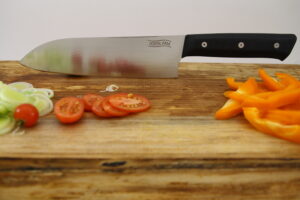 This was our original finish. The knife bevel is milled as a series of shallow steps (from 0.001 to 0.003 inches each depending on the model). We then polish the bevel with various grits before and after heat treat, ending up with a bright reflective sheen. The CNC lines remain visible, adding a unique texture to the blade.
This was our original finish. The knife bevel is milled as a series of shallow steps (from 0.001 to 0.003 inches each depending on the model). We then polish the bevel with various grits before and after heat treat, ending up with a bright reflective sheen. The CNC lines remain visible, adding a unique texture to the blade.Polished Stonewash
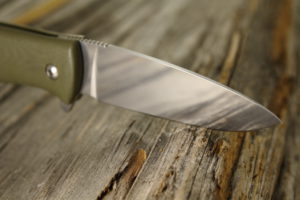 This finish is now the standard finish for all models. The blade bevel is ground, and then tumbled in ceramic media to remove grinding scratches and further tumbled to create a smoother and more reflective finish.
This finish is now the standard finish for all models. The blade bevel is ground, and then tumbled in ceramic media to remove grinding scratches and further tumbled to create a smoother and more reflective finish.
Orders
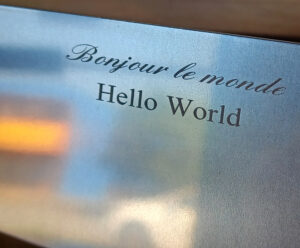
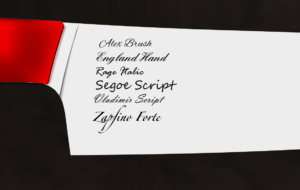
Knife Maintenance
Before you start
Removing the old handle scales
Preparation before installing new handle scales
Attaching the scales
Finishing up
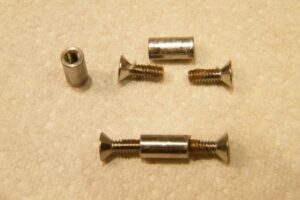 There may be times when you need to or want to disassemble your knife and you’d like to know the screw sizes involved. For our Skaha folder, because of its moving parts and internal bearings, disassembly for service is more likely than for our fixed blade models. We do have an article on typical fixed blade handle removal and replacement.
There may be times when you need to or want to disassemble your knife and you’d like to know the screw sizes involved. For our Skaha folder, because of its moving parts and internal bearings, disassembly for service is more likely than for our fixed blade models. We do have an article on typical fixed blade handle removal and replacement.
Sharpening
Routine Cleaning
Skaha screw and driver sizes
Adjusting pivot tightness
Disassembly and Reassembly
Services


Shipping
Destinations
Costs
Order Tracking
Warranty
Satisfaction Guarantee
Lifetime Warranty
Knife Care

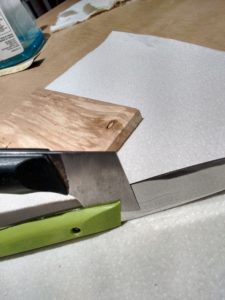
Leave a Reply